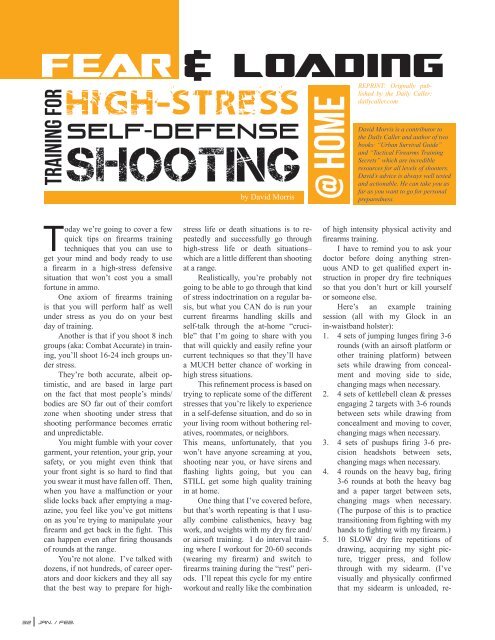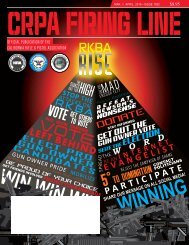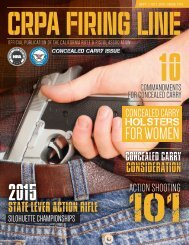CRPA Jan-Feb 2016
Create successful ePaper yourself
Turn your PDF publications into a flip-book with our unique Google optimized e-Paper software.
FEAR & LOADING<br />
Training for<br />
HIGH-STRESS<br />
Self-Defense<br />
Shooting<br />
by David Morris<br />
@ Home<br />
REPRINT: Orignally published<br />
by the Daily Caller:<br />
dailycaller.com<br />
David Morris is a contributor to<br />
the Daily Caller and author of two<br />
books: “Urban Survival Guide”<br />
and “Tactical Firearms Training<br />
Secrets” which are incredible<br />
resources for all levels of shooters.<br />
David’s advice is always well tested<br />
and actionable. He can take you as<br />
far as you want to go for personal<br />
preparedness.<br />
Today we’re going to cover a few<br />
quick tips on firearms training<br />
techniques that you can use to<br />
get your mind and body ready to use<br />
a firearm in a high-stress defensive<br />
situation that won’t cost you a small<br />
fortune in ammo.<br />
One axiom of firearms training<br />
is that you will perform half as well<br />
under stress as you do on your best<br />
day of training.<br />
Another is that if you shoot 8 inch<br />
groups (aka: Combat Accurate) in training,<br />
you’ll shoot 16-24 inch groups under<br />
stress.<br />
They’re both accurate, albeit optimistic,<br />
and are based in large part<br />
on the fact that most people’s minds/<br />
bodies are SO far out of their comfort<br />
zone when shooting under stress that<br />
shooting performance becomes erratic<br />
and unpredictable.<br />
You might fumble with your cover<br />
garment, your retention, your grip, your<br />
safety, or you might even think that<br />
your front sight is so hard to find that<br />
you swear it must have fallen off. Then,<br />
when you have a malfunction or your<br />
slide locks back after emptying a magazine,<br />
you feel like you’ve got mittens<br />
on as you’re trying to manipulate your<br />
firearm and get back in the fight. This<br />
can happen even after firing thousands<br />
of rounds at the range.<br />
You’re not alone. I’ve talked with<br />
dozens, if not hundreds, of career operators<br />
and door kickers and they all say<br />
that the best way to prepare for highstress<br />
life or death situations is to repeatedly<br />
and successfully go through<br />
high-stress life or death situations–<br />
which are a little different than shooting<br />
at a range.<br />
Realistically, you’re probably not<br />
going to be able to go through that kind<br />
of stress indoctrination on a regular basis,<br />
but what you CAN do is run your<br />
current firearms handling skills and<br />
self-talk through the at-home “crucible”<br />
that I’m going to share with you<br />
that will quickly and easily refine your<br />
current techniques so that they’ll have<br />
a MUCH better chance of working in<br />
high stress situations.<br />
This refinement process is based on<br />
trying to replicate some of the different<br />
stresses that you’re likely to experience<br />
in a self-defense situation, and do so in<br />
your living room without bothering relatives,<br />
roommates, or neighbors.<br />
This means, unfortunately, that you<br />
won’t have anyone screaming at you,<br />
shooting near you, or have sirens and<br />
flashing lights going, but you can<br />
STILL get some high quality training<br />
in at home.<br />
One thing that I’ve covered before,<br />
but that’s worth repeating is that I usually<br />
combine calisthenics, heavy bag<br />
work, and weights with my dry fire and/<br />
or airsoft training. I do interval training<br />
where I workout for 20-60 seconds<br />
(wearing my firearm) and switch to<br />
firearms training during the “rest” periods.<br />
I’ll repeat this cycle for my entire<br />
workout and really like the combination<br />
of high intensity physical activity and<br />
firearms training.<br />
I have to remind you to ask your<br />
doctor before doing anything strenuous<br />
AND to get qualified expert instruction<br />
in proper dry fire techniques<br />
so that you don’t hurt or kill yourself<br />
or someone else.<br />
Here’s an example training<br />
session (all with my Glock in an<br />
in-waistband holster):<br />
1. 4 sets of jumping lunges firing 3-6<br />
rounds (with an airsoft platform or<br />
other training platform) between<br />
sets while drawing from concealment<br />
and moving side to side,<br />
changing mags when necessary.<br />
2. 4 sets of kettlebell clean & presses<br />
engaging 2 targets with 3-6 rounds<br />
between sets while drawing from<br />
concealment and moving to cover,<br />
changing mags when necessary.<br />
3. 4 sets of pushups firing 3-6 precision<br />
headshots between sets,<br />
changing mags when necessary.<br />
4. 4 rounds on the heavy bag, firing<br />
3-6 rounds at both the heavy bag<br />
and a paper target between sets,<br />
changing mags when necessary.<br />
(The purpose of this is to practice<br />
transitioning from fighting with my<br />
hands to fighting with my firearm.)<br />
5. 10 SLOW dry fire repetitions of<br />
drawing, acquiring my sight picture,<br />
trigger press, and follow<br />
through with my sidearm. (I’ve<br />
visually and physically confirmed<br />
that my sidearm is unloaded, re-<br />
32<br />
JAN. / FEB.








